2016 Hyundai Santa Fe ECO mode
[x] Cancel search: ECO modePage 549 of 759
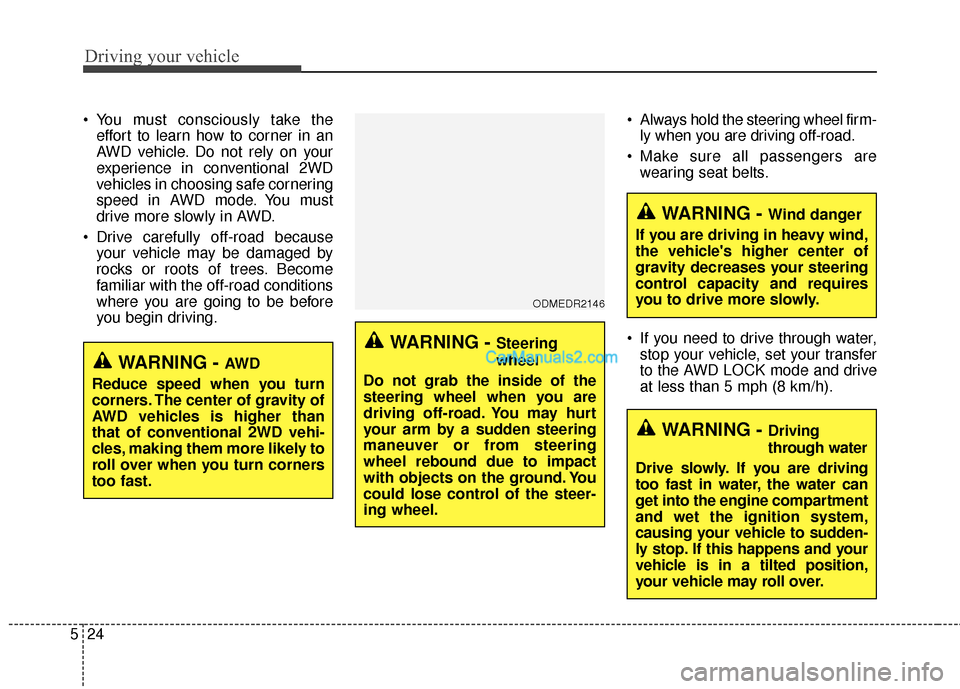
Driving your vehicle
24
5
You must consciously take the
effort to learn how to corner in an
AWD vehicle. Do not rely on your
experience in conventional 2WD
vehicles in choosing safe cornering
speed in AWD mode. You must
drive more slowly in AWD.
Drive carefully off-road because your vehicle may be damaged by
rocks or roots of trees. Become
familiar with the off-road conditions
where you are going to be before
you begin driving. Always hold the steering wheel firm-
ly when you are driving off-road.
Make sure all passengers are wearing seat belts.
If you need to drive through water, stop your vehicle, set your transfer
to the AWD LOCK mode and drive
at less than 5 mph (8 km/h).
WARNING - Steering
wheel
Do not grab the inside of the
steering wheel when you are
driving off-road. You may hurt
your arm by a sudden steering
maneuver or from steering
wheel rebound due to impact
with objects on the ground. You
could lose control of the steer-
ing wheel.
WARNING - Wind danger
If you are driving in heavy wind,
the vehicle's higher center of
gravity decreases your steering
control capacity and requires
you to drive more slowly.
WARNING - Driving
through water
Drive slowly. If you are driving
too fast in water, the water can
get into the engine compartment
and wet the ignition system,
causing your vehicle to sudden-
ly stop. If this happens and your
vehicle is in a tilted position,
your vehicle may roll over.
ODMEDR2146
WARNING - AW D
Reduce speed when you turn
corners. The center of gravity of
AWD vehicles is higher than
that of conventional 2WD vehi-
cles, making them more likely to
roll over when you turn corners
too fast.
Page 567 of 759
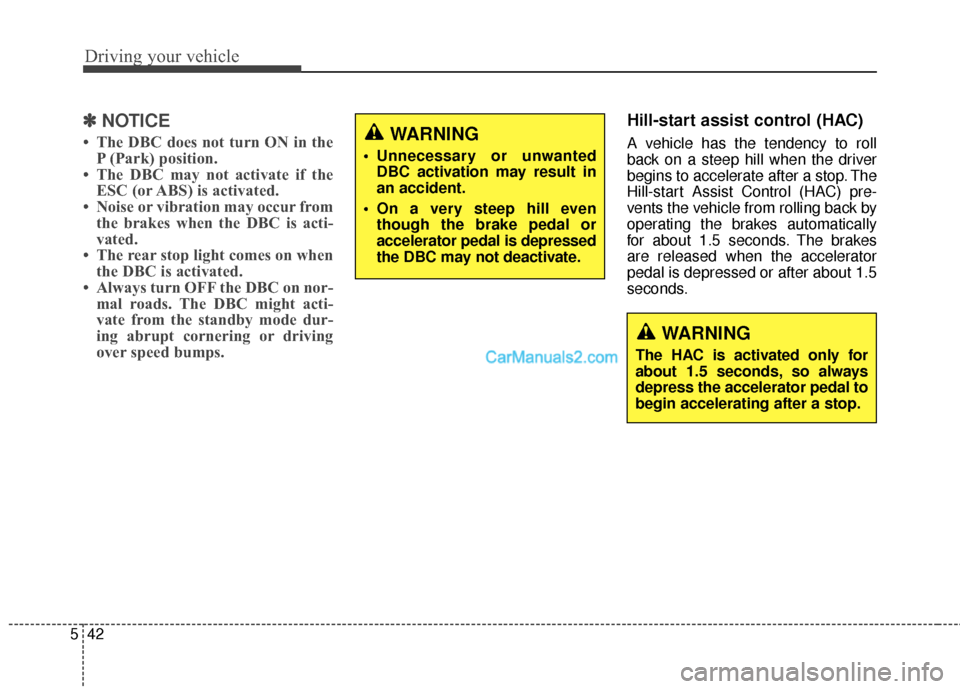
Driving your vehicle
42
5
✽
✽
NOTICE
• The DBC does not turn ON in the
P (Park) position.
• The DBC may not activate if the ESC (or ABS) is activated.
• Noise or vibration may occur from the brakes when the DBC is acti-
vated.
• The rear stop light comes on when the DBC is activated.
• Always turn OFF the DBC on nor- mal roads. The DBC might acti-
vate from the standby mode dur-
ing abrupt cornering or driving
over speed bumps.
Hill-start assist control (HAC)
A vehicle has the tendency to roll
back on a steep hill when the driver
begins to accelerate after a stop. The
Hill-start Assist Control (HAC) pre-
vents the vehicle from rolling back by
operating the brakes automatically
for about 1.5 seconds. The brakes
are released when the accelerator
pedal is depressed or after about 1.5
seconds.WARNING
Unnecessary or unwanted
DBC activation may result in
an accident.
On a very steep hill even though the brake pedal or
accelerator pedal is depressed
the DBC may not deactivate.
WARNING
The HAC is activated only for
about 1.5 seconds, so always
depress the accelerator pedal to
begin accelerating after a stop.
Page 581 of 759
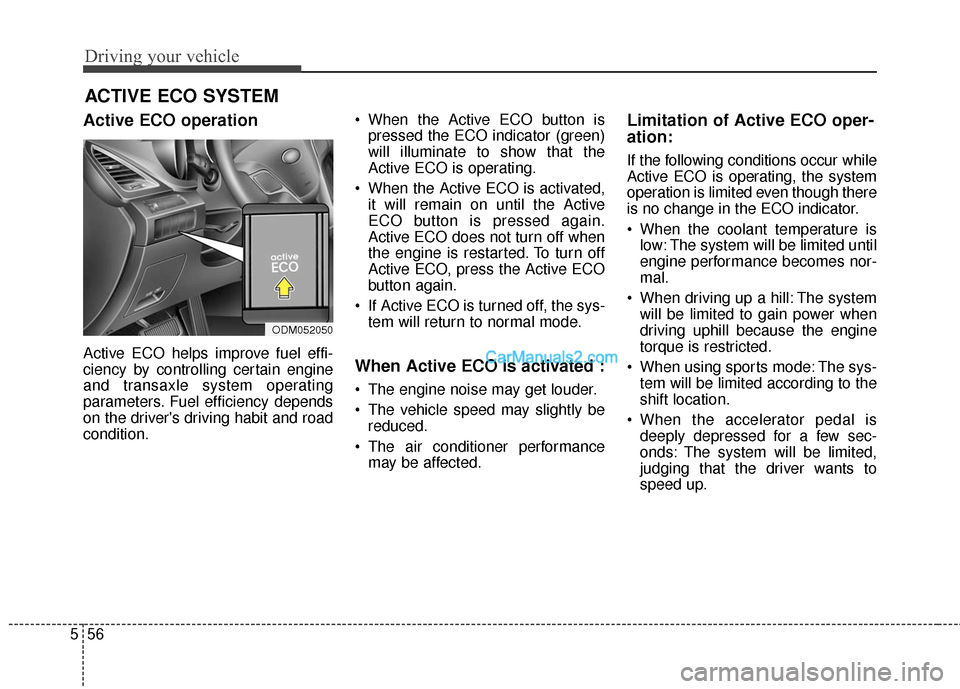
Driving your vehicle
56
5
Active ECO operation
Active ECO helps improve fuel effi-
ciency by controlling certain engine
and transaxle system operating
parameters. Fuel efficiency depends
on the driver's driving habit and road
condition. When the Active ECO button is
pressed the ECO indicator (green)
will illuminate to show that the
Active ECO is operating.
When the Active ECO is activated, it will remain on until the Active
ECO button is pressed again.
Active ECO does not turn off when
the engine is restarted. To turn off
Active ECO, press the Active ECO
button again.
If Active ECO is turned off, the sys- tem will return to normal mode.When Active ECO is activated :
The engine noise may get louder.
The vehicle speed may slightly bereduced.
The air conditioner performance may be affected.
Limitation of Active ECO oper-
ation:
If the following conditions occur while
Active ECO is operating, the system
operation is limited even though there
is no change in the ECO indicator.
When the coolant temperature islow: The system will be limited until
engine performance becomes nor-
mal.
When driving up a hill: The system will be limited to gain power when
driving uphill because the engine
torque is restricted.
When using sports mode: The sys- tem will be limited according to the
shift location.
When the accelerator pedal is deeply depressed for a few sec-
onds: The system will be limited,
judging that the driver wants to
speed up.
ACTIVE ECO SYSTEM
ODM052050
Page 582 of 759
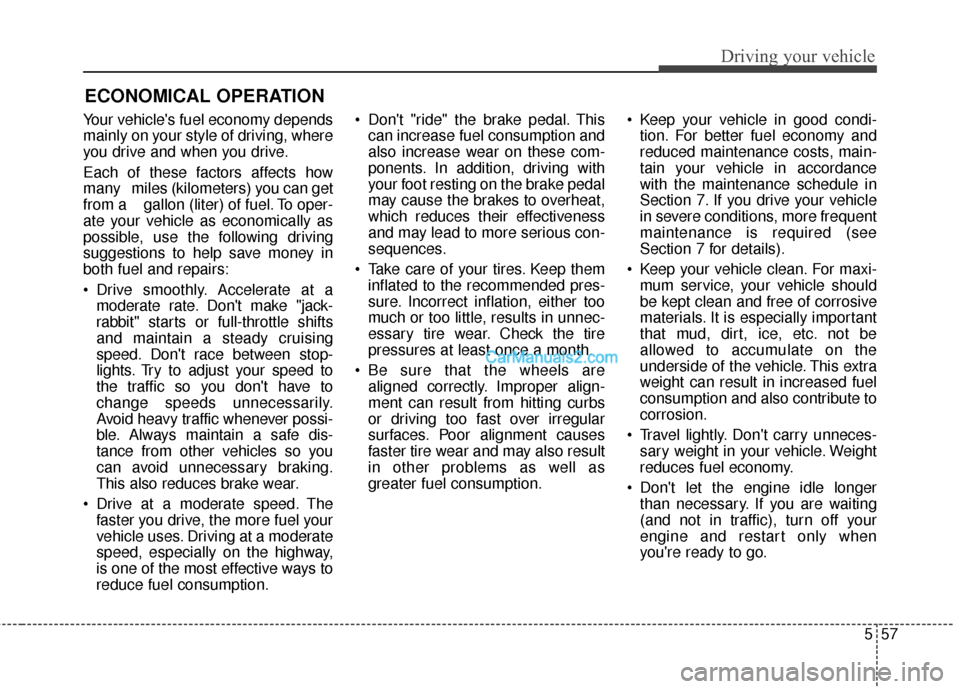
557
Driving your vehicle
Your vehicle's fuel economy depends
mainly on your style of driving, where
you drive and when you drive.
Each of these factors affects how
many miles (kilometers) you can get
from a gallon (liter) of fuel. To oper-
ate your vehicle as economically as
possible, use the following driving
suggestions to help save money in
both fuel and repairs:
Drive smoothly. Accelerate at amoderate rate. Don't make "jack-
rabbit" starts or full-throttle shifts
and maintain a steady cruising
speed. Don't race between stop-
lights. Try to adjust your speed to
the traffic so you don't have to
change speeds unnecessarily.
Avoid heavy traffic whenever possi-
ble. Always maintain a safe dis-
tance from other vehicles so you
can avoid unnecessary braking.
This also reduces brake wear.
Drive at a moderate speed. The faster you drive, the more fuel your
vehicle uses. Driving at a moderate
speed, especially on the highway,
is one of the most effective ways to
reduce fuel consumption. Don't "ride" the brake pedal. This
can increase fuel consumption and
also increase wear on these com-
ponents. In addition, driving with
your foot resting on the brake pedal
may cause the brakes to overheat,
which reduces their effectiveness
and may lead to more serious con-
sequences.
Take care of your tires. Keep them inflated to the recommended pres-
sure. Incorrect inflation, either too
much or too little, results in unnec-
essary tire wear. Check the tire
pressures at least once a month.
Be sure that the wheels are aligned correctly. Improper align-
ment can result from hitting curbs
or driving too fast over irregular
surfaces. Poor alignment causes
faster tire wear and may also result
in other problems as well as
greater fuel consumption. Keep your vehicle in good condi-
tion. For better fuel economy and
reduced maintenance costs, main-
tain your vehicle in accordance
with the maintenance schedule in
Section 7. If you drive your vehicle
in severe conditions, more frequent
maintenance is required (see
Section 7 for details).
Keep your vehicle clean. For maxi- mum service, your vehicle should
be kept clean and free of corrosive
materials. It is especially important
that mud, dirt, ice, etc. not be
allowed to accumulate on the
underside of the vehicle. This extra
weight can result in increased fuel
consumption and also contribute to
corrosion.
Travel lightly. Don't carry unneces- sary weight in your vehicle. Weight
reduces fuel economy.
Don't let the engine idle longer than necessary. If you are waiting
(and not in traffic), turn off your
engine and restart only when
you're ready to go.
ECONOMICAL OPERATION
Page 701 of 759
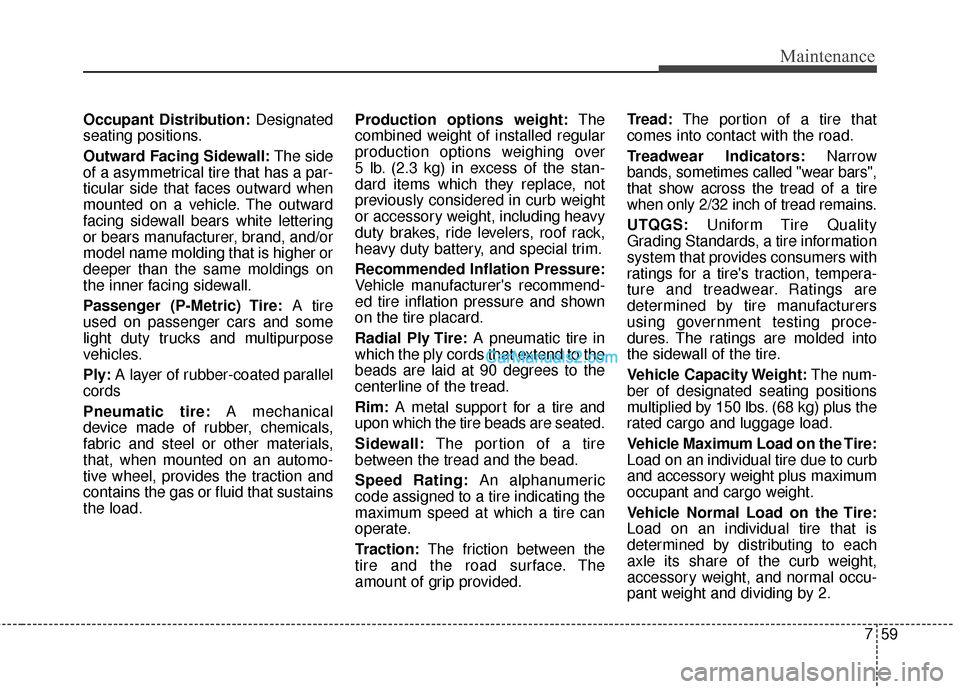
759
Maintenance
Occupant Distribution:Designated
seating positions.
Outward Facing Sidewall: The side
of a asymmetrical tire that has a par-
ticular side that faces outward when
mounted on a vehicle. The outward
facing sidewall bears white lettering
or bears manufacturer, brand, and/or
model name molding that is higher or
deeper than the same moldings on
the inner facing sidewall.
Passenger (P-Metric) Tire: A tire
used on passenger cars and some
light duty trucks and multipurpose
vehicles.
Ply: A layer of rubber-coated parallel
cords
Pneumatic tire: A mechanical
device made of rubber, chemicals,
fabric and steel or other materials,
that, when mounted on an automo-
tive wheel, provides the traction and
contains the gas or fluid that sustains
the load. Production options weight:
The
combined weight of installed regular
production options weighing over
5 lb. (2.3 kg) in excess of the stan-
dard items which they replace, not
previously considered in curb weight
or accessory weight, including heavy
duty brakes, ride levelers, roof rack,
heavy duty battery, and special trim.
Recommended Inflation Pressure:
Vehicle manufacturer's recommend-
ed tire inflation pressure and shown
on the tire placard.
Radial Ply Tire: A pneumatic tire in
which the ply cords that extend to the
beads are laid at 90 degrees to the
centerline of the tread.
Rim: A metal support for a tire and
upon which the tire beads are seated.
Sidewall: The portion of a tire
between the tread and the bead.
Speed Rating: An alphanumeric
code assigned to a tire indicating the
maximum speed at which a tire can
operate.
Traction: The friction between the
tire and the road surface. The
amount of grip provided. Tread:
The portion of a tire that
comes into contact with the road.
Treadwear Indicators: Narrow
bands, sometimes called "wear bars",
that show across the tread of a tire
when only 2/32 inch of tread remains.
UTQGS: Uniform Tire Quality
Grading Standards, a tire information
system that provides consumers with
ratings for a tire's traction, tempera-
ture and treadwear. Ratings are
determined by tire manufacturers
using government testing proce-
dures. The ratings are molded into
the sidewall of the tire.
Vehicle Capacity Weight: The num-
ber of designated seating positions
multiplied by 150 lbs. (68 kg) plus the
rated cargo and luggage load.
Vehicle Maximum Load on the Tire:
Load on an individual tire due to curb
and accessory weight plus maximum
occupant and cargo weight.
Vehicle Normal Load on the Tire:
Load on an individual tire that is
determined by distributing to each
axle its share of the curb weight,
accessory weight, and normal occu-
pant weight and dividing by 2.
Page 702 of 759
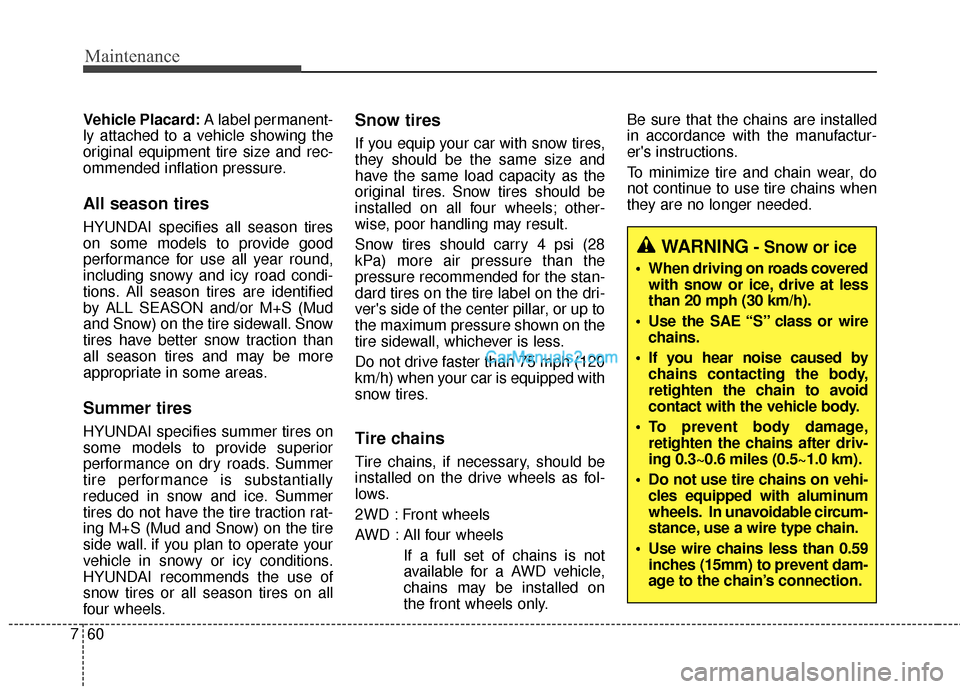
Maintenance
60
7
Vehicle Placard: A label permanent-
ly attached to a vehicle showing the
original equipment tire size and rec-
ommended inflation pressure.
All season tires
HYUNDAI specifies all season tires
on some models to provide good
performance for use all year round,
including snowy and icy road condi-
tions. All season tires are identified
by ALL SEASON and/or M+S (Mud
and Snow) on the tire sidewall. Snow
tires have better snow traction than
all season tires and may be more
appropriate in some areas.
Summer tires
HYUNDAI specifies summer tires on
some models to provide superior
performance on dry roads. Summer
tire performance is substantially
reduced in snow and ice. Summer
tires do not have the tire traction rat-
ing M+S (Mud and Snow) on the tire
side wall. if you plan to operate your
vehicle in snowy or icy conditions.
HYUNDAI recommends the use of
snow tires or all season tires on all
four wheels.
Snow tires
If you equip your car with snow tires,
they should be the same size and
have the same load capacity as the
original tires. Snow tires should be
installed on all four wheels; other-
wise, poor handling may result.
Snow tires should carry 4 psi (28
kPa) more air pressure than the
pressure recommended for the stan-
dard tires on the tire label on the dri-
ver's side of the center pillar, or up to
the maximum pressure shown on the
tire sidewall, whichever is less.
Do not drive faster than 75 mph (120
km/h) when your car is equipped with
snow tires.
Tire chains
Tire chains, if necessary, should be
installed on the drive wheels as fol-
lows.
2WD : Front wheels
AWD : All four wheels
If a full set of chains is not
available for a AWD vehicle,
chains may be installed on
the front wheels only. Be sure that the chains are installed
in accordance with the manufactur-
er's instructions.
To minimize tire and chain wear, do
not continue to use tire chains when
they are no longer needed.
WARNING - Snow or ice
When driving on roads covered
with snow or ice, drive at less
than 20 mph (30 km/h).
Use the SAE “S” class or wire chains.
If you hear noise caused by chains contacting the body,
retighten the chain to avoid
contact with the vehicle body.
To prevent body damage, retighten the chains after driv-
ing 0.3~0.6 miles (0.5~1.0 km).
Do not use tire chains on vehi- cles equipped with aluminum
wheels. In unavoidable circum-
stance, use a wire type chain.
Use wire chains less than 0.59 inches (15mm) to prevent dam-
age to the chain’s connection.
Page 750 of 759

Index
2I
A/V Mode .....................................................................4-8\
2
AC inverter .................................................................4-153
Active ECO..............................................................\
.....5-56
Air bag collision sensors ..............................................3-70
Air bag inflation conditions..........................................3-71
Air bag non-inflation conditions ..................................3-73
Air bag warning label ...................................................3-77
Air bag warning light ...................................................3-52
Air bags................................................................\
.........3-49Air bag collision sensors ...........................................3-70
Air bag inflation conditions ......................................3-71
Air bag non-inflation conditions ...............................3-73
Air bag warning label................................................3-77
Air bag warning light ................................................3-52
Curtain air bag...........................................................3-68
Driver's front air bag .................................................3-62
Occupant classification system .................................3-56
Operation ...................................................................3-50
Passenger's front air bag............................................3-60
Side impact air bag....................................................3-65
SRS components and functions ................................3-52
Air cleaner ....................................................................7-38\
Air conditioning system .................................................8-5
All wheel drive (4WD) .................................................5-21
Antenna .......................................................................4\
-161
Anti-lock brake system (ABS) .....................................5-32 Appearance care ...........................................................7-84
Exterior care ..............................................................7-84
Interior care ...............................................................7-89
Armrest (Rear seat).......................................................3-17
Audio remote control..................................................4-161
Audio system ..............................................................4-161 Antenna ...................................................................4-161\
Audio remote control ..............................................4-161
Auto light position ......................................................4-114
Automatic climate control system ..............................4-135 3rd row climate control ...........................................4-143
Automatic heating and air conditioning..................4-137
Manual heating and air conditioning ......................4-137
Automatic transaxle ......................................................5-14 Shift-lock override ....................................................5-18
Sports mode...............................................................5-17
Automatic turn off function ........................................4-120
Aux, USB and iPod
®..................................................4-156
Battery.................................................................\
..........7-45
Battery saver function .................................................4-111
Before driving .................................................................5-3
Blind spot detection system (BSD) ..............................5-50
Blue Link
®center .........................................................4-67
Bottle holder, see Cup holders ...................................4-150
Brake system............................................................\
.....5-28
A
B
Page 752 of 759
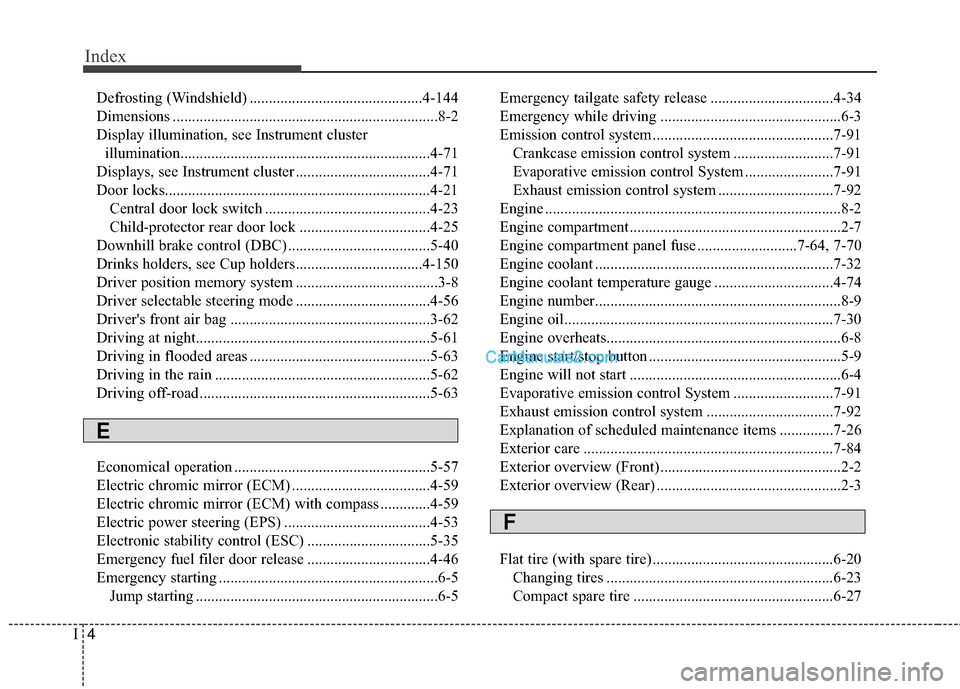
Index
4I
Defrosting (Windshield) .............................................4-144
Dimensions .....................................................................8-2\
Display illumination, see Instrument cluster illumination.................................................................4-71
Displays, see Instrument cluster ...................................4-71
Door locks..............................................................\
.......4-21 Central door lock switch ...........................................4-23
Child-protector rear door lock ..................................4-25
Downhill brake control (DBC) .....................................5-40
Drinks holders, see Cup holders.................................4-150
Driver position memory system .....................................3-8
Driver selectable steering mode ...................................4-56
Driver's front air bag ....................................................3-62
Driving at night.............................................................5-61
Driving in flooded areas ...............................................5-63
Driving in the rain ........................................................5-62
Driving off-road ............................................................5-63
Economical operation ...................................................5-57
Electric chromic mirror (ECM) ....................................4-59
Electric chromic mirror (ECM) with compass .............4-59
Electric power steering (EPS) ......................................4-53
Electronic stability control (ESC) ................................5-35
Emergency fuel filer door release ................................4-46
Emergency starting .........................................................6-5 Jump starting ...............................................................6-5 Emergency tailgate safety release ................................4-34
Emergency while driving ...............................................6-3
Emission control system ...............................................7-91
Crankcase emission control system ..........................7-91
Evaporative emission control System .......................7-91
Exhaust emission control system ..............................7-92
Engine ........................................................................\
.....8-2
Engine compartment .......................................................2-7
Engine compartment panel fuse ..........................7-64, 7-70
Engine coolant ..............................................................7-32
Engine coolant temperature gauge ...............................4-74
Engine number................................................................8-9
Engine oil......................................................................7-\
30
Engine overheats.............................................................6-8
Engine start/stop button ..................................................5-9
Engine will not start .......................................................6-4
Evaporative emission control System ..........................7-91
Exhaust emission control system .................................7-92
Explanation of scheduled maintenance items ..............7-26
Exterior care .................................................................7-84
Exterior overview (Front) ...............................................2-2
Exterior overview (Rear) ................................................2-3
Flat tire (with spare tire) ...............................................6-20 Changing tires ...........................................................6-23
Compact spare tire ....................................................6-27
E
F